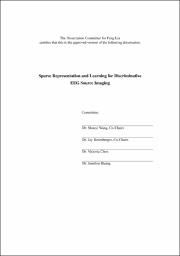
ATTENTION: The works hosted here are being migrated to a new repository that will consolidate resources, improve discoverability, and better show UTA's research impact on the global community. We will update authors as the migration progresses. Please see MavMatrix for more information.
Show simple item record
| dc.contributor.advisor | Wang, Shouyi | |
| dc.contributor.advisor | Rosenberger, Jay M. | |
| dc.creator | Liu, Feng | |
| dc.date.accessioned | 2019-07-08T22:22:26Z | |
| dc.date.available | 2019-07-08T22:22:26Z | |
| dc.date.created | 2018-05 | |
| dc.date.issued | 2018-05-07 | |
| dc.date.submitted | May 2018 | |
| dc.identifier.uri | http://hdl.handle.net/10106/28307 | |
| dc.description.abstract | As a direct measurement modality of neural electrical firing patterns, electroencephalogram (EEG) has a much higher temporal resolution up to millisecond compared to positron emission topography (PET) and functional magnetic resonance imaging (fMRI) and it has become one of the popular neuroimaging tools to find signatures of brain diseases and to understand how the brain works. Other advantages of EEG include low cost, easy portability, and non-invasive. However, a limitation of EEG is its low spatial resolution since the measurement is on the scalp rather than inside the brain. Given the recorded scalp EEG data, to reconstruct the activated brain sources signal inside the brain is known as EEG inverse problem or EEG source imaging (ESI). ESI technique has been widely used in the study of language mechanisms, cognition process, sensory function, as well as the localization of epileptic seizure, etc. However, due to the existing strong spontaneous background source activations, traditional ESI methods will inevitably incur the spurious activation patterns that are not task-related.
In this dissertation, we proposed the idea of discriminative ESI which aims to find the task-related sources and reduce the contamination from high background noises or spurious sources and reformulated the traditional ESI problem by using label information. Discriminative source activation pattern corresponding to different cognitive tasks provides more insights compared to the activation pattern reconstructed from traditional methods. To discover discriminative ESI, label information was integrated to the traditional ESI problem, and several frameworks have been proposed: (1) A sparse dictionary learning framework was proposed and a revised version of discriminative K-SVD (DK-SVD) algorithm is given to solve the formulated supervised dictionary learning problem. As the proposed learning framework incorporated the EEG label information of different brain status, it is capable of learning a sparse representation that reveals the most discriminative brain activity sources among different brain states. (2) A graph regularized ESI model, which implicitly use label information in the graph regularization term to promote in-class consistency and out-class discrimination, an efficient algorithm called feature sign search is used to optimize the proposed model. (3) As ESI solution always favors spatially smooth activation pattern instead of isolated discrete activations, we included first-order total variation (TV) and spatial graph Fractional Order Total Variation (gFOTV) with ADMM algorithm and practical technique to find a better spatially smoothing source activations. (4) Traditional ESI methods usually do not distinguish the task-related and spurious non-task-related sources that jointly generate EEG signal, which will inevitably yield misleading reconstructed activation patterns. We proposed to infer the true task-related EEG sources location by exploiting its low-rank property. To find a source activation pattern with low-rank structure, a novel ESI model based on low-rank representation was developed. Simulation results illustrate the effectiveness of those several proposed methods under different Signal Noise Ratio (SNR) and a variant of source configuration settings. | |
| dc.format.mimetype | application/pdf | |
| dc.language.iso | en_US | |
| dc.subject | EEG Source Imaging | |
| dc.subject | Sparse representation | |
| dc.subject | Convex optimization | |
| dc.subject | Augmented Lagrangian Multiplier | |
| dc.title | Sparse Representation and Learning for Discriminative EEG Source Imaging | |
| dc.type | Thesis | |
| dc.degree.department | Industrial and Manufacturing Systems Engineering | |
| dc.degree.name | Doctor of Philosophy in Industrial Engineering | |
| dc.date.updated | 2019-07-08T22:22:27Z | |
| thesis.degree.department | Industrial and Manufacturing Systems Engineering | |
| thesis.degree.grantor | The University of Texas at Arlington | |
| thesis.degree.level | Doctoral | |
| thesis.degree.name | Doctor of Philosophy in Industrial Engineering | |
| dc.type.material | text | |
| dc.creator.orcid | 0000-0002-5225-8199 | |
Files in this item
- Name:
- LIU-DISSERTATION-2018.pdf
- Size:
- 20.30Mb
- Format:
- PDF
This item appears in the following Collection(s)
Show simple item record


